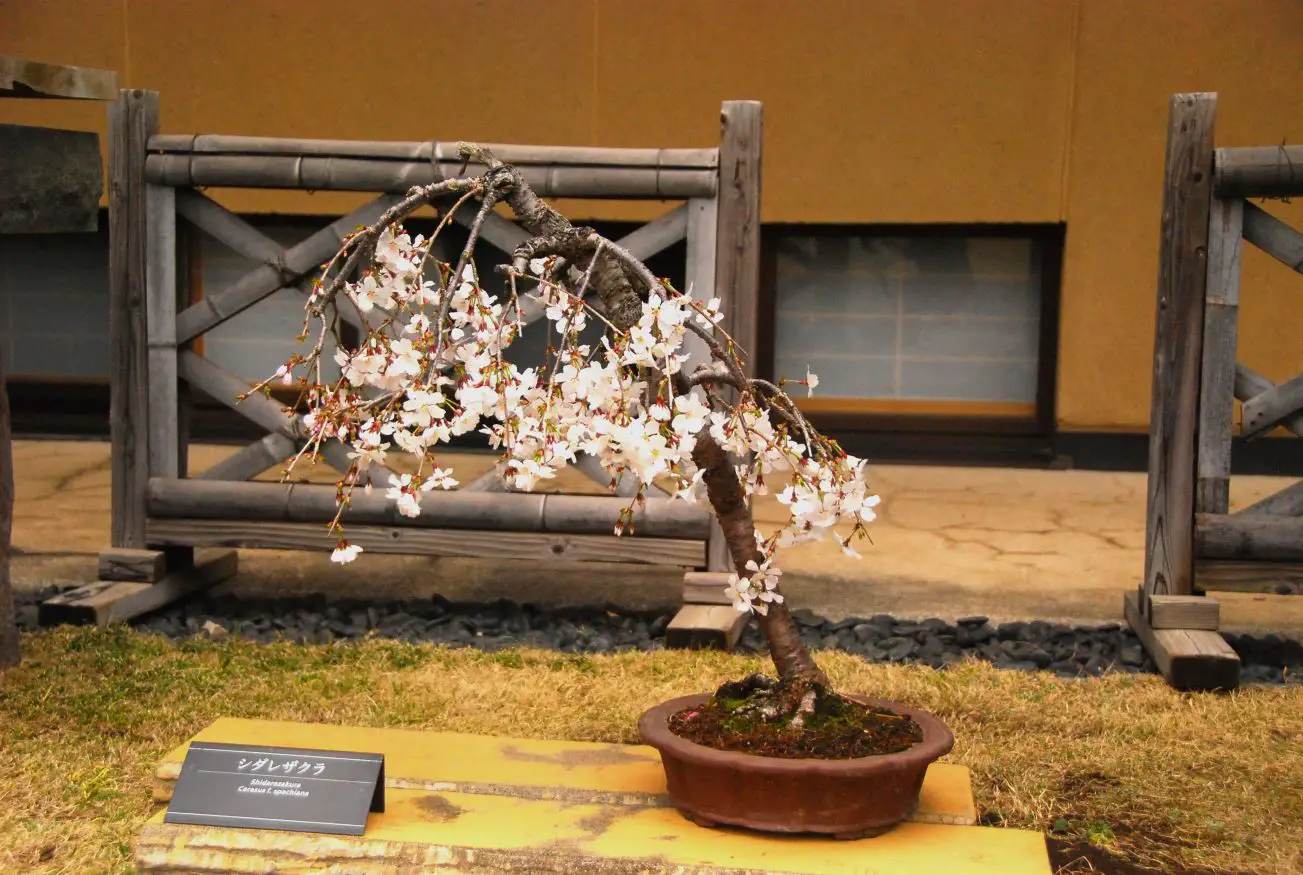Why isn’t your cherry blossom bonsai blooming?
If you’ve been having trouble captivating blooms for your cherry blossom bonsai, you’re not alone. In this chapter, we’ll embark on an exploration of the factors that might be influencing your bonsai’s flowering reluctance.
Insufficient Sunlight
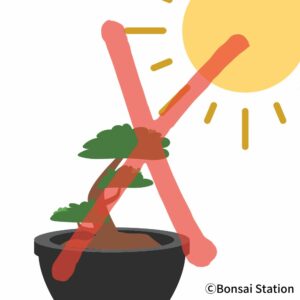
Sunlight plays a crucial role in the blooming process of your cherry blossom bonsai. One of the primary reasons why your cherry blossom bonsai is not blooming may be due to insufficient sunlight.
Like most “traditional” bonsai trees, cherry blossoms are sun-loving trees: they require plenty of sunlight to trigger the blooming process. So, when they don’t receive enough sunlight, their ability to produce flowers can be adversely affected.
If you are placing your cherry blossom bonsai indoors or outside but in full shade all day long, it may be why your tree isn’t blooming.
Improper Temperature

Temperature plays a significant role in flower formation as each species has an optimal temperature range for flower initiation and development. If your cherry blossom bonsai is not blooming as expected, improper temperature conditions could be a contributing factor.
Cherry blossom bonsai temperature needs
According to research, temperatures around 68°F (20°C) are optimal for cherry blossom flower bud initiation. For healthy bud development, the temperature needs to drop to around 50°F (10°C) in the later stage.
At temperatures above 77°F (25°C), flower bud initiation and development stagnate and do not progress as usual.
Deviations from this ideal range can affect their ability to produce flowers.
Nutrient Excess/Deficiency
Proper nutrition is essential for the health and vitality of your cherry blossom bonsai and excess nutrient or its deficiencies can significantly impact its ability to produce abundant blooms.
Cherry blossom bonsai nutritional needs
All plants require essential nutrients such as nitrogen, phosphorus, and potassium. Of these, cherry blossom bonsai have an emphasized need for phosphorous; it is a critical nutrient for flowering, and phosphorus deficiencies can cause limited flower development.
Excess nutrient
While P is important for flowering, it is the nitrogen level applied to the cherry blossom bonsai tree that controls its transition from vegetative growth to reproductive growth.
Applying too much nitrogen or the presence of nitrogen in the soil at the time of flower bud initiation can disrupt the flowering process as the tree may prioritize vegetative growth and delay or inhibit the formation of flower buds.
Nutrient deficiency
It is important for cherry blossom bonsai to accumulate carbohydrates to form abundant flower buds. For this, they need to have enough branches and leaves to produce energy that can well be assisted by well-balanced nutrition in the soil.
Any deficiency or lack of essential nutrients can hinder their blooming potential.
Pruning Mistakes
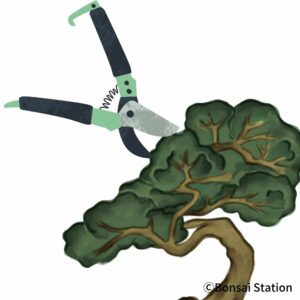
Pruning mistakes can have a significant impact on the flower production of your cherry blossom bonsai. Pruning at the wrong time is the most common pruning mistake in cherry blossom bonsai that interfere with blooming.
Pruning at the wrong time
Generally speaking, pruning cherry blossom bonsai after August will likely remove some or most of the flower buds for the next season. It may also reverse flower buds that started to develop back to vegetative buds to compensate for the lost leaves and stems.
Incorrect Watering Practices
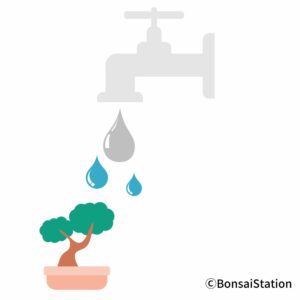
Watering is a fundamental aspect of bonsai care, and improper watering practices can significantly impact their blooming potential.
Cherry blossom bonsai loves water and is prone to water stress. Especially, lack of water in summer is likely to cause leaf scorch, which negatively affects the accumulation of energy for subsequent flower bud initiation and development.
That said, excess watering especially at the time of flower bud formation in late summer can promote vegetative growth (i.e. leaf and stem) rather than flower buds. Mild drought stress at the flower bud initiation period can in fact promote more numbers of flower buds, leading to higher blooming rates.
Winter Cold/ Spring Frost

Spring frost or winter cold can indeed be significant factors affecting the blooming of cherry blossom bonsai. If the buds are exposed to frost or extremely cold temperatures, it can cause damage and result in reduced or no blooming.
The minimum viable temperature for cherry blossom flower buds is around -4°F (-20°C) during dormancy. Its hardiness weakens as they awaken for blooming in early spring and exposing flower buds to frost may well damage them.
Generally, flower buds are more vulnerable to cold than the whole tree because they contain more water and they lack the protective layers that the mature parts of the tree possess. So, even if the tree looks completely healthy, flower buds can be affected by cold.
It is probably best if you understand what the flowering process is for bonsai trees and how it proceeds to identify the reason why your cherry blossom bonsai isn’t flowering. For this, the following article may be helpful.
How to make cherry blossom bonsai bloom
In this chapter, we’ll unravel the science of nurturing cherry blossom bonsai for full blossom.
Provide optimal light conditions

Adequate sunlight is vital for the healthy growth and blooming of your cherry blossom bonsai. Sunlight provides the energy needed for photosynthesis, which supports the production of essential nutrients and the development of flower buds.
Choose the right location
Cherry blossom is a sun-loving tree. Place your bonsai where it can receive sunlight throughout the day. Outdoor bonsai like cherry blossom generally require direct sunlight for at least 6-8 hours per day.
I wouldn’t recommend growing your cherry blossom bonsai indoors. Lack of adequate sunlight may likely cause less blooming.
Provide shade in summer if necessary
Be mindful of the intensity of the summer sunlight your bonsai receives. While cherry blossom bonsai thrives under direct sunlight, excessive heat from intense afternoon sun or scorching summer temperatures can stress the tree and damage leaves.
If your region experiences hot summer with intensive sunlight, provide some shade (not full shade) during the hottest part of the day to protect your bonsai from sunburn.
Maintaining the Right Temperature Range
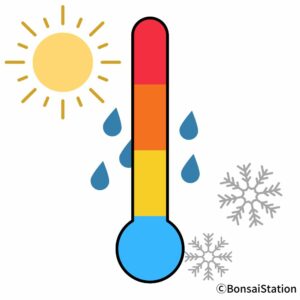
Temperature is a critical factor in the blooming success of your cherry blossom bonsai. Maintaining the right temperature range is essential for promoting flower bud development and abundant blooms.
Cherry blossom bonsai temperature needs
Temperatures around 68°F (20°C) are optimal for cherry blossom flower bud initiation. The development of flower buds is suppressed with temperatures higher than 77°F (25°C).
The optimum temperature range for cherry blossom flower bud development is around 59°F (15°C) during the early stage and may fall to around 50°F (10°C) in the later stage.
Winter cold
A certain degree of low-temperature exposure in winter is necessary for cherry blossom bonsai for normal flowering. The temperature has to be below 41°F (5°C) and the duration should be a month or two, depending on the species.
During winter, their growth and blooming activity slow down or temporarily cease. This is a natural part of their life cycle and they resume as temperatures become more favorable in spring. Your cherry blossom bonsai needs exactly this for a spring bloom.
Fertilizing for Blooms
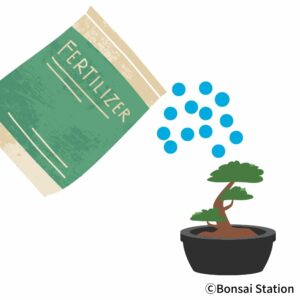
Fertilizing plays a crucial role in supporting the blooming potential of your cherry blossom bonsai. Providing the right nutrients at the appropriate times can encourage robust flower bud formation and enhance their blooming.
Choose the right fertilizer
All plants require essential nutrients such as nitrogen, phosphorus, and potassium. Of these three, cherry blossom bonsai have an emphasized need for phosphorous which is a critical nutrient for flowering.
You can choose a fertilizer specifically formulated for flowering bonsai trees such as cherry blossom. The following product from Amazon is a slow-release bonsai bloom fertilizer with an N-P-K ratio of 6-8-10 and is perfect for your cherry blossom bonsai.
You can also choose a balanced bonsai fertilizer that will give ideal growth for all bonsai trees including cherry blossom bonsai trees. (N-P-K ratio is 12-11-10 for the following product.)
When giving fertilizer, make sure no excess nitrogen remains in the soil at the time of flower bud formation in late summer.
Pruning for Flower Production

Pruning is a fundamental practice in bonsai care, and when done correctly, it can enhance the overall health of your cherry blossom bonsai and encourage healthy flowering.
Timing for pruning
Timing is everything when it comes to pruning for flowering. For cherry blossom bonsai, the best time to prune for optimal blooming is after flowering, which is in late spring to early summer.
Flower buds of cherry blossom are formed in late summer to fall and pruning before this period ensures full blossom. Also, pruning at this time allows the tree to store energy from the leaves and branches, which will support the development of new flower buds for the following season.
Note that pruning for styling is best done in late fall after leaves have fallen.
Mastering Proper Watering Techniques
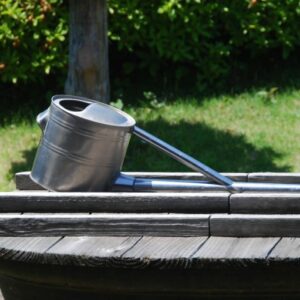
Proper watering is essential for the health, growth, and blooming success of your cherry blossom bonsai. Both overwatering and underwatering can have detrimental effects on your bonsai’s blooming.
Cherry blossom bonsai water needs
Cherry blossom bonsai loves water and is vulnerable to water stress.
Watering frequency for abundant blooming
It is generally recommended to water cherry blossom bonsai 2 to 3 times a day in summer and 1 to 2 a day in fall depending on the climate (temperature, humidity, and wind). Severe drought stress during summer will likely cause leaf scorch, which would hinder flower bud initiation.
That said, mild drought stress at the flower bud initiation period can promote more numbers of flower buds. Avoid keeping the soil consistently wet and water thoroughly when it is dry.
Providing Protection from Cold

To prevent flower buds from cold damage during winter and early spring, consider implementing the following protective measures.
Monitor weather
Stay informed about weather forecasts and temperature trends. This is very important. Cherry blossom is generally quite cold hardy but a sudden drop in temperature or late spring frost may harm flower buds.
If cold weather is expected in your region, plan protective measures in advance based on anticipated cold spells.
Windshield
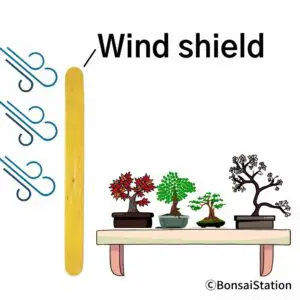
Windshield
Shield your bonsai from cold winds by placing it near a natural windbreak, such as a wall or larger plants. Or you can move your tree inside the barn or other places where it can be protected from cold and dry winds.
Plant cloth
Cover your bonsai with plant cloth (shade cloth will do) on nights when frost or freezing temperatures are expected. This provides an extra layer of protection against cold air and frost.
—–
References
五井正憲. (1982). 温帯花木の花芽形成ならびに開花調節に関する研究. 香川大学農学部紀要, 38, 1-120. (Goi, Masanori. (1981). Studies on the flower formation and forcing of some ornamental trees and shrubs native to East Asia, Kyoto University.)

